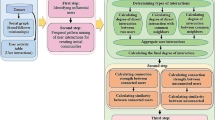Abstract
This paper is concerned with a problem of detecting relational changes. Many kinds of graph data including social networks are increasing nowadays. In such a graph, the relationships among vertices are changing day by day. Therefore, it would be worth investigating a data mining method for detecting significant patterns informing us about what changes. We present in this paper a general framework for detecting relational changes over two graphs to be contrasted. Our target pattern with relational change is defined as a set of vertices common in both graphs in which the vertices are almost disconnected in one graph, while densely connected in the other. We formalize such a target pattern based on the notions of modularity and k-plex. A depth-first algorithm for the mining task is designed as an extension of k-plex enumerators with some pruning mechanisms. Our experimental results show usefulness of the proposed method for two pairs of graphs representing actual reply-communications among Twitter users and word co-occurrence relations in Japanese news articles.
Access this chapter
Tax calculation will be finalised at checkout
Purchases are for personal use only
Preview
Unable to display preview. Download preview PDF.
Similar content being viewed by others
References
Tomita, E., Tanaka, A., Takahashi, H.: The Worst-Case Time Complexity for Generating All Maximal Cliques and Computational Experiments. Theoretical Computer Science 363(1), 28–42 (2006)
Dilkina, B., Gomes, C.P.: Solving Connected Subgraph Problems in Wildlife Conservation. In: Lodi, A., Milano, M., Toth, P. (eds.) CPAIOR 2010. LNCS, vol. 6140, pp. 102–116. Springer, Heidelberg (2010)
Li, A., Haraguchi, M., Okubo, Y.: Contrasting Correlations by an Efficient Double-Clique Condition. In: Perner, P. (ed.) MLDM 2011. LNCS (LNAI), vol. 6871, pp. 469–483. Springer, Heidelberg (2011)
Terlecki, P., Walczak, K.: Efficient Discovery of Top-K Minimal Jumping Emerging Patterns. In: Chan, C.-C., Grzymala-Busse, J.W., Ziarko, W.P. (eds.) RSCTC 2008. LNCS (LNAI), vol. 5306, pp. 438–447. Springer, Heidelberg (2008)
Bay, S.D., Pazzani, M.J.: Detecting Group Differences: Mining Contrast Sets. Data Mining and Knowledge Discovery 5(3), 213–246 (2001)
Newman, M.E.J.: Finding Community Structure in Networks Using the Eigenvectors of Matrices. Physical Review E 74(3), 36104 (2006)
Seidman, S.B., Foster, B.L.: A Graph Theoretic Generalization of the Clique Concept. Journal of Mathematical Sociology 6(1), 139–154 (1978)
Wu, B., Pei, X.: A Parallel Algorithm for Enumerating All the Maximal k-Plexes. In: Washio, T., Zhou, Z.-H., Huang, J.Z., Hu, X., Li, J., Xie, C., He, J., Zou, D., Li, K.-C., Freire, M.M. (eds.) PAKDD 2007. LNCS (LNAI), vol. 4819, pp. 476–483. Springer, Heidelberg (2007)
Kaufmann, M., Wagner, D. (eds.): Drawing Graphs. LNCS, vol. 2025. Springer, Heidelberg (2001)
Li, A., Haraguchi, M., Okubo, Y., Tomita, E.: Finding What Changes for Two Graphs Constructed from Different Time Intervals. In: The 2012 IIAI International Conference on Advanced Applied Informatics, pp. 48–53. CPS, California (2012)
Okubo, Y., Haraguchi, M., Tomita, E.: Structural Change Pattern Mining Based on Constrained Maximal k-Plex Search. In: Ganascia, J.-G., Lenca, P., Petit, J.-M. (eds.) DS 2012. LNCS, vol. 7569, pp. 284–298. Springer, Heidelberg (2012)
Author information
Authors and Affiliations
Editor information
Editors and Affiliations
Rights and permissions
Copyright information
© 2013 Springer-Verlag Berlin Heidelberg
About this paper
Cite this paper
Okubo, Y., Haraguchi, M., Tomita, E. (2013). Relational Change Pattern Mining Based on Modularity Difference. In: Ramanna, S., Lingras, P., Sombattheera, C., Krishna, A. (eds) Multi-disciplinary Trends in Artificial Intelligence. MIWAI 2013. Lecture Notes in Computer Science(), vol 8271. Springer, Berlin, Heidelberg. https://doi.org/10.1007/978-3-642-44949-9_18
Download citation
DOI: https://doi.org/10.1007/978-3-642-44949-9_18
Publisher Name: Springer, Berlin, Heidelberg
Print ISBN: 978-3-642-44948-2
Online ISBN: 978-3-642-44949-9
eBook Packages: Computer ScienceComputer Science (R0)




